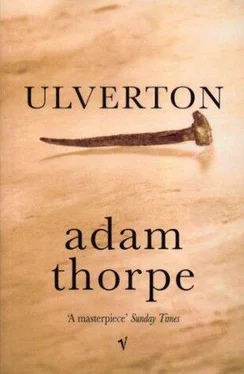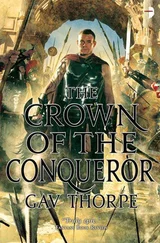On fine summer days of good light, preferably on a Sunday, when the fever of the week’s activities ceases, and the drone of the plump bumble-bee is the busiest sound above the sigh of the waters by the mill, the clanking of buckets at the well, and the idle chatter of the population at the wayside (or, alas, upon the tavern benches!), then nothing pleases better than to wrap my machine in brown paper, leaving but a slit for aperture, and wander the Village and its environs for human subjects that may be caught without that formality of response, that considered design and self-conscious air, that the posed picture erstwhile involves. Indeed, in this wise we gentler sex have a distinct advantage, for what better use my otherwise cumbersome crinoline, than as a type of black hood or cover? — if pockets be cut into the material, so that the camera may be held within and remain unseen.
Imagine my pleasure, then, when faint murmurings came to me upon the towpath, and on creeping forward what should I have seen to my astonishment, but the oldest and loveliest of all scenes — two lovers in a boat, in the first and most innocent bloom of love: that first courtship which Shakespeare and all our immortal poets have, at their most exquisite and poignant, immortalised for the world to cherish. May I add my own small reed upon the altar, with this picture, which has as its protagonists not the Illyrian lords and ladies but the rustics of Arden. Or — to be more prosaic and (in the true manner of this art) precise — two of the labouring class, whose vessel is a craft belonging to the butcher and renowned for its leaking qualities, that has soaked the hem of my own dress before now (it serves as the general factotum for the Village at a penny a time): With (I might say) only a moment’s hesitation, I plucked this bloom in its full glory — or rather (as might be conceived from the girl’s attitude) in its ‘crumpled bud’ phase, for Silvius appeared distinctly unripe in these matters (he is, I later ascertained, the eldest son of the harness maker, and she a horseman’s daughter — though whether yet happily bridled is not for me to say).
This part of Ulverton is called of old ‘the Vanners’ — for what reason I cannot discover. Bottom Bridge is just concealed by the verdant curve; though mediaeval in origin, it is little more than a footbridge, of partly wooden structure, and is soon to be replaced, thus removing the reliance of carriages on the oft-flooded ford beside it. I made several attempts to photograph this bridge, but none was successful. It is said, in the less enlightened corners of our parish, that long ago it was the haunt of a woman, whose love for a man (a departed seaman) went unrequited: until, after many years of waiting upon its boards, she donned widow’s weeds, threw herself from the rail, and quickly drowned. My lack of success was no doubt due, in the view of these credulous folk, to the woman’s ghostly presence — that blacked out the plates.
Plate XXVII THE HOUSEHOLD OF SIR HUMPHREY CHALMERS, M.P., AT ULVERTON HOUSE
The posing of large groups should present no special difficulties, if it is remembered by the enthusiastic photographer that heads and hands are forever eager to make their mark and ruin the picture in fuss and needless business, especially where head supports are undesirable. Long exposure is necessary for full detail: it is to be noted here, for instance, that the gold buttons of the footman (fourth from left) are exactly rendered; for the occupation of this gentleman means that the frigidity of good posing presents him with no difficulties, used as he is to ‘standing guard’. The plump figure slightly to the front is the steward: his stovepipe has exaggerated the trembling of his head (the result of an injury received, I was informed, as a drummer boy at Waterloo) and I might, if I were (God willing!) to repeat the exercise, request that this good man remove the offending headwear. On the either extremity I have turned the ladies (parlourmaids only) inwards, so that the eye is drawn to the centre of the group, thence to the magnificent copper beeches behind, and so to the house. On the extreme left the edge of the lake might be regarded as a distraction, being heightened by the two swans, but such a picturesque detail could hardly be rejected, and the weighty stature of the house supersedes all else. I do not know what the faint figure in the extreme rear of the picture was doing, for I did not notice him at the time: it must be stressed, that the photographer on this sort of commission must make as sure as possible that the area within the camera’s purview is cleared of distractions.
The large laurel hedge to the right, beyond the first beech, is home to a curious, and apparently veracious, legend — though I have heard other versions: a humble shepherd, by the name of William, employee to the Chalmers family in the middle years of the last century, would hide within the said shrubbery in order to view secretly his adored mistress. His distraction eventually forcing him to sea, he ended his days under the lash of an overseer’s whip upon a sugar plantation — his visage being so darkened by his downland office, that he was taken for a black in those merciless times. Ulverton House is a fine example of the work of Sir John Vanbrugh, though the Gothic hall on the right is a recent addition. The gardens were laid out by the renowned William Kent, but have undergone numerous minor alterations since that date. A Royal visit, by our own sovereign, was made here a few years past, and it was for that reason the terrace was hung with thirty Venetian-glassed wrought-iron lamps, the fine detail of which is fully visible in this picture, despite the distance from the lens. The foreground distortion of the lawn is, I need hardly explain, owing to the wide angle of the subject.
I might add that the somewhat surly expression of the assembled group (in particular the two stout gardeners with their lawn-mowing machine on the right) may be explained not only by the difficulty of retaining a smile for some minutes, but also by a cold East wind that was blowing at that time across the lawn, lifting up the odd dry leaf, and affecting detrimentally the sharpness of the large dress of the governess (fifth from right) that has billowed alarmingly — a hazard with all outdoor work. Since most domestics are naturally of a surly disposition, at least in this writer’s experience, I have once again rendered the facts visibly and honestly, and improved nothing.
Plate XXVIII A COTTAGE ROOF
The enthusiastic photographer must always be on the watch for Nature’s tiny miracles: those effects which urban dwellers lack, and in their smoky habitat grow dulled from, so that the soul remains unmoved by simple glories. Herein is the principal task, then, of the new art of the lens: for what other purpose must we serve but the bettering of humankind, in the bringing to its attention that miraculous system that has its being all about us but that we too easily take for granted: for Time hurries us on, and our needs make us blind.
Here is a simple cottage roof — or rather, a detail from that structure — to illuminate and (if I may be so bold) impart instruction of a spiritual nature. The original is to be discovered down a muddy track known as Surley Row, at the northern extreme of the village, and presents, to the uninitiated observer, a most dilapidated and unattractive prospect. But it is in these areas that the photographic artist wanders with most reward: nothing more profoundly salubrious than an old stone wall, nothing richer than a bedraggled plum-tree, nothing more enticing than a raven’s discarded feather, or a dust-filled barn spread with ancient sacks, or a pond wherein the weeds lie dank and idly swaying! For upon these surfaces lies a cornucopia of satisfying differences, that the lens, with its unavailing sincerity, and its unjudging eye, captures upon the plate with a fidelity of draughtsmanship the great Leonardo might have envied. My own soul is moved, not by the ornate sculpture of a great house, or the sighing willows of a great garden — but by the winter branch, the puddled track, a white surf of Shepherd’s Purse in a meadow, the silvery plumes of Traveller’s Joy upon a hedgerow, the frayed hem of a cotter’s shawl. And here, dear viewer, note what riches are to be found if only the eye would seek them out! This is no longer the moss-grown, decaying, vermin-ridden blanket beneath which poverty strives to keep the chill at bay, but a glittering tapestry of loveliness, a source of meticulous meditation, and an assurance that even the humblest and most wretched of abodes is not neglected by the Almighty’s brush.
Читать дальше










